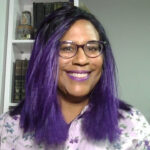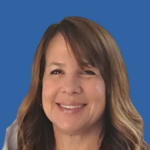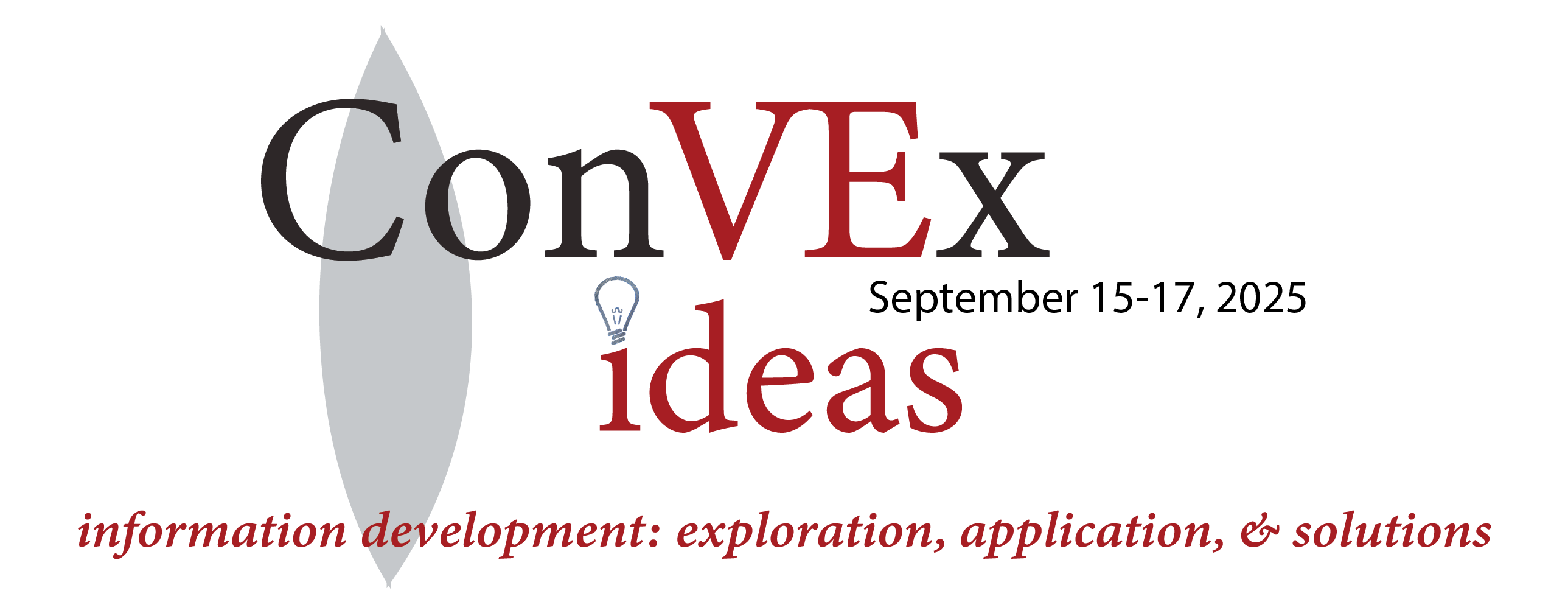Agenda
We’ve taken the best of our past ConVEx and IDEAS and created a new panel-based interactive virtual conference.
We invite you to participate in 12 panel discussions with industry professionals to learn tips and trends to help you hone your skills.
Inclusive Language
Scott Abel, John Horodyski, and Abi Bettle-Shaffer discuss the following questions and more:

- How are you or your company making people aware of inclusive language?
- What determines whether content is considered inclusive or not? Who are we trying to include?
- How can using inclusive language make technical documentation more inviting and understandable?
- What impact do inclusivity initiatives have on translation and localization, and vice versa?
- How can technical documentation lead the way for corporations who have not yet created an inclusive language policy?
- What are ways to lead inclusive language efforts from the top, from the bottom, from the middle?
- Is inclusivity just related to language or also the way content is presented?
- How do you reconcile the idea of designing for specific personas with the concept of inclusivity? Aren’t you purposely leaving some people out of consideration?
- What are good resources for inclusive language?
- APA Equality, Diversity, and Inclusion Inclusive Language Guidelines https://www.apa.org/about/apa/equity-diversity-inclusion/language-guidelines.pdf
- https://apastyle.apa.org/style-grammar-guidelines/bias-free-language/disability
- https://archive.ada.gov/pcatoolkit/chap5chklist.htm
- https://www.workhuman.com/blog/what-is-inclusive-language-in-the-workplace/
- https://architecture.lullabot.com/adr/20220511-use-inclusive-language/
Scott Abel, The Content Wrangler

Dubbed “The Content Wrangler,” Scott Abel is the Founder and President of The Content Wrangler Inc, a global content strategy consultancy. Scott Abel is a content management strategist and exponential growth evangelist. He specializes in helping content-heavy organizations improve the way they author, maintain, publish and archive their information assets.
Scott publishes a series of content strategy books for XML Press and is the producer of several content industry events including Technical Documentation Roundup and Information Development World.
John Horodyski, Salt Flats

World leading expert, thought leader, and executive with management strategy experience in Information Management including Digital Asset Management (DAM), Content Strategy, Metadata and Taxonomy design, Content Management, Governance, and Rights Management.
Abi Bettle-Shaffer, IBM

I have been a content developer at IBM for many years, and now I am Team Lead for Security, Foundation, Modern Languages, and Performance – for CICS TS. This is an exciting role, combining my interpersonal skills with my project management skills.
Web Analytics

Gaby Scott, Lonnye Yancey-Smith, and Aditi Kashikar discuss the following questions and more:
- What are the critical data points that every publication manager should have readily available?
- What else do you measure and why?
- Are there any analytics you purposefully ignore?
- Do you look at users as a whole or break down the analytics in some way, such as region, country, or language?
- What should you consider before you make changes based on analytics?
- Data can be misleading without context. How do you gather the context? What is the appropriate balance of quantitative vs qualitative data?
- Is there such a thing as too much data? How much should people be collecting?
- How often does data need to be collected?
- One of the most common questions we get at Comtech is how to prove the value of documentation. What metrics would you recommend?
Gaby Scott, NantHealth
 Gaby Scott is a highly accomplished professional with 13+ years of experience in technical writing and content development. She received the Pendo Business Impact Award in 2022 for implementing the NaviNet 101 user onboarding process, enhancing user success and satisfaction. As Senior Manager of Content Development at NantHealth, Gaby focuses on increasing self-service capabilities and user engagement. With expertise in content design, Agile methodologies, and tools like Zoomin, Salesforce, Pendo, and DITA, she leverages technology and data to improve user experiences.
Gaby Scott is a highly accomplished professional with 13+ years of experience in technical writing and content development. She received the Pendo Business Impact Award in 2022 for implementing the NaviNet 101 user onboarding process, enhancing user success and satisfaction. As Senior Manager of Content Development at NantHealth, Gaby focuses on increasing self-service capabilities and user engagement. With expertise in content design, Agile methodologies, and tools like Zoomin, Salesforce, Pendo, and DITA, she leverages technology and data to improve user experiences.
Lonnye Yancey-Smith, Hexagon

With more than 25 years of experience in technical writing and documentation management, Lonnye Yancey-Smith is the Director of User Assistance at Hexagon’s Asset Lifecycle Intelligence division, where she manages a global team responsible for product documentation and e-learning. In this role, Lonnye is responsible for defining and communicating Hexagon’s documentation and e-learning vision for Hexagon’s software solutions and leading the global adoption of documentation tools, a documentation web site, and a learning management system. Focusing on customer success through User Assistance, documentation analytics has become a passion for Lonnye over the past few years.
Aditi Kashikar, Automation Anywhere
 Aditi brings over 17 years of experience in the technical communications space, having worked in diverse domains, such as enterprise content management, networking, and robotic process automation (RPA). She heads a global Product Documentation team at Automation Anywhere, a global leader in RPA.
Aditi brings over 17 years of experience in the technical communications space, having worked in diverse domains, such as enterprise content management, networking, and robotic process automation (RPA). She heads a global Product Documentation team at Automation Anywhere, a global leader in RPA.
She is passionate about improving user experience and enabling customer success through content. In her current leadership role, she is instrumental in the implementation of a data- and user research-driven content strategy and a design-thinking approach to content development. She is equally passionate about growing and developing people and setting them up for success in their careers.
Outside of work, Aditi enjoys traveling and indulging in adventure sports.
Unifying Content (Enterprise-wide strategies)
Josh Steves and Priya Shetty discuss the following questions and more:
- What initiatives do you have at your company to unify your content strategy?

- What are the important components of a unified content strategy? Give some examples.
- What are the typical points of content strategy contention among silos?
- How do you facilitate compromise and reach consensus?
- How do you address the inherent differences between audience and purpose of content when trying to create a unified content strategy?
- How should a content strategy address the differing skills and interests of the people doing the writing?
- A unified content strategy is not necessarily unified content tactics. What is the difference? How can groups have a unified strategy but take different paths to conform?
- How often should you revisit your strategy to keep it current? What should you be monitoring to determine if a change might be needed?
- How do you enforce a unified strategy? What kind of reviews are required?
- What advice would you give someone who is trying to create or overhaul their current content strategy?
Josh Steves, IRMI
 Content leader with a 10-year track record of innovation, problem-solving, and improvement resulting in award-winning operational efficiencies. Cross-functional skills across disciplines: strategic thinking, project management, systems implementation & training, change management, scripting & automation, content development & architecture, web writing & design.
Content leader with a 10-year track record of innovation, problem-solving, and improvement resulting in award-winning operational efficiencies. Cross-functional skills across disciplines: strategic thinking, project management, systems implementation & training, change management, scripting & automation, content development & architecture, web writing & design.
Priya Shetty, CommScope

Priya Shetty is a Director of Technical Publications and Training at CommScope, with over 20 years in content development. She successfully led her team through the transition to structured authoring and DITA, while implementing a unified content strategy. Over the years, she spearheaded several initiatives related to content development and delivery with a focus on streamlining processes and improving team efficiency.
Process Maturity/DITA Maturity
Dawn Stevens, Sarah O’Keefe, and Amber Swope discuss the following questions and more:
- Why is assessing/considering maturity important?

- All your companies created a maturity model. What is a 3-minute summary of what your maturity model covers.
- At what organizational level should maturity be assessed? Is it an enterprise consideration?
- How does maturity affect content strategy and overall content quality?
- What are critical indicators/symptoms that indicate how mature an organization is?
- How do organizations move up the scale?
- Is the goal always the top level of the maturity scale? What if your content doesn’t need it?
- What could cause a backslide down the maturity scale? What should you do if you backslide?
- How has the industry changed so that the models have needed to change? What future changes do you see on the horizon that might affect your models?
- Do you need a third party to give you an honest assessment?
Dawn Stevens, Comtech Services
 Dawn Stevens is the President, and owner of Comtech Services and the Director of the Center for Information-Development Management. With over 32 years of experience, including 20 years at Comtech, Dawn has practical experience in virtually every role within a documentation and training department, including project management, instructional design, writing, editing, and multimedia programming. With both engineering and technical communication degrees, Dawn combines a solid technical foundation with strong writing and design skills to identify and remove the challenges her clients face in producing usable, technical information and training.
Dawn Stevens is the President, and owner of Comtech Services and the Director of the Center for Information-Development Management. With over 32 years of experience, including 20 years at Comtech, Dawn has practical experience in virtually every role within a documentation and training department, including project management, instructional design, writing, editing, and multimedia programming. With both engineering and technical communication degrees, Dawn combines a solid technical foundation with strong writing and design skills to identify and remove the challenges her clients face in producing usable, technical information and training.
Sarah O’Keefe, Scriptorium
 Sarah O’Keefe, Chief Executive Officer, founded Scriptorium Publishing to work at the intersection of content, technology, and publishing. Today, she leads an organization known for expertise in solving business-critical content problems with a special focus on product and technical content. Sarah identifies and assesses new trends and their effects on the industry.
Sarah O’Keefe, Chief Executive Officer, founded Scriptorium Publishing to work at the intersection of content, technology, and publishing. Today, she leads an organization known for expertise in solving business-critical content problems with a special focus on product and technical content. Sarah identifies and assesses new trends and their effects on the industry.
Amber Swope, DITA Strategies
 Amber Swope is an internationally recognized DITA expert and information architect. With over 20 years of experience in information development and 15 with DITA, Amber aids organizations in creating opportunity through IA. She helps teams build scalable IA solutions to future-enable their content and mentors team members to advance the IA as it evolves to meet new business needs.
Amber Swope is an internationally recognized DITA expert and information architect. With over 20 years of experience in information development and 15 with DITA, Amber aids organizations in creating opportunity through IA. She helps teams build scalable IA solutions to future-enable their content and mentors team members to advance the IA as it evolves to meet new business needs.
CCMS Implementation: State of Preparedness
Chip Gettinger, Rob Kimm, and Jarod Sickler discuss the following questions and more:
- What misconceptions or unrealistic expectations do companies have about a content management system?
- What considerations are frequently overlooked during a CCMS selection process?
- What considerations are overemphasized in the selection process?
- What are the biggest mistakes companies make when implementing a CCMS?
- What do you wish companies brought to the table at the start of an implementation?
- Who should be involved during the implementation/configuration process?
- What decisions have to be made during implementation? What if they make the wrong choices to start?
- Where can things go wrong during a CCMS implementation and what should companies do to avoid and mitigate these things?
- How long should companies expect an implementation to take, from contract to go-live? What can make this timeline go faster or slower?
- What are indicators of a successful implementation?
Chip Gettinger, RWS
 Chip manages a team who work with customers in maximizing global digital content utilizing RWS content technologies. He has experience working with customers to develop digital content strategies, business requirements, change management and technology adoption structured content management utilizing Semantic AI.
Chip manages a team who work with customers in maximizing global digital content utilizing RWS content technologies. He has experience working with customers to develop digital content strategies, business requirements, change management and technology adoption structured content management utilizing Semantic AI.
Rob Kimm, IXIASOFT

Bio Coming Soon
Jarod Sickler, Heretto

Bio Coming Soon
Customer Advisory Board (User Focus)
Melanie Davis and Julia Stevenson discuss the following questions and more:
- What is a customer advisory board?
- Why should technical writers do user research? Isn’t that work typically done by marketing, usability, and product development professionals?
- What is the significance of having a user advisory board for technical content? Isn’t it enough to track documentation success through web analytics and/or surveys?
- How can a technical writer with limited bandwidth begin the journey of establishing a user advisory board?
- What challenges have you experienced while establishing a user advisory board for technical content? How did you tackle (or how do you intend to tackle) those challenges?
- How do you find users to participate on a customer advisory board?
- How do users benefit from giving feedback on technical documentation? What’s in it for them?
- What are some “Dos” and “Don’ts” when collecting user feedback on technical content?
Melanie Davis, Reltio

Melanie Davis is a passionate professional communicator specializing in technical data transformation and content curation. She is a long-term industry veteran with experience as a technical writer, editor, localization coordinator, project optimizer, and content technology and system architect. She has a solid reputation for instituting and enhancing lightweight and effective project process and product documentation, which she is currently exercising as Sr Manager, Content Tools and Technology, at Reltio.
Julia Stevenson, Hypertherm

Julia Stevenson has 15+ years of technical communication experience. In her current role, she develops technical content for global users of industrial metal cutting hardware and software at Hypertherm Associates.
Julia is at the start of a journey to create a User Advisory Board for technical content. She also has experience documenting APIs and SaaS products.
Julia likes to climb mountains and spend time with her kids in nature.
Generative AI/Chat GPT
Michael Iantosca, Lance Cummings, Scott Abel, and Val Swisher discuss the following questions and more:
- How are you, or others that you know, making use of generative AI today?
- What do you foresee will be the impact of generative AI on the technical communication industry?
- Is generative AI a tool for authors or a tool for our users?
- How does generative AI change and/or reinforce current industry best practices for creating content, such as structured authoring, minimalism, and metadata and taxonomy requirements?
- How can technical communication departments take control of generative AI strategies within their companies?
- What data accessibility, cybersecurity, and transparency standards should be established in using generative AI?
- What are good starting points for making use of generative AI today?
- What are the dangers/risks of generative AI and how can we avoid them?
- What are the common misperceptions about generative AI and how do we correct/overcome them?
- How do you recommend individuals learn more about generative AI?
Michael Iantosca, Avalara
 Michael Iantosca is the Senior Director of Content Platforms at Avalara Inc. Michael spent 38 of his 42 years at IBM as a content professional and pioneer – leading the design and development of multiple generations of advanced content management systems and technology that began at the very dawn of the structured content revolution in the early 80s. Dual trained as a content professional and systems engineer, he led the charge building some of the earliest content platforms based on structured content. Michael formed the team at IBM that developed DITA XML, began his foray into AI starting Expert Systems in the early 90s, followed by computational linguistics, IBM Watson, and knowledge engineering. Michael formed the Semantic Content Graph Guild (SCGG) that meets monthly and whose work is key the future of AI and ML-driven content and generative technologies.
Michael Iantosca is the Senior Director of Content Platforms at Avalara Inc. Michael spent 38 of his 42 years at IBM as a content professional and pioneer – leading the design and development of multiple generations of advanced content management systems and technology that began at the very dawn of the structured content revolution in the early 80s. Dual trained as a content professional and systems engineer, he led the charge building some of the earliest content platforms based on structured content. Michael formed the team at IBM that developed DITA XML, began his foray into AI starting Expert Systems in the early 90s, followed by computational linguistics, IBM Watson, and knowledge engineering. Michael formed the Semantic Content Graph Guild (SCGG) that meets monthly and whose work is key the future of AI and ML-driven content and generative technologies.
Lance Cummings, Univ. North Carolina

Lance Cummings is an associate professor of English in the Professional Writing program at the University of North Carolina Wilmington. Dr. Cummings explores content and information development in technologically and culturally diverse contexts. His most recent work looks at how to leverage structured content with rhetorical strategies to improve the performance of generative AI technologies.
Scott Abel, The Content Wrangler

Dubbed “The Content Wrangler,” Scott Abel is the Founder and President of The Content Wrangler Inc, a global content strategy consultancy. Scott Abel is a content management strategist and exponential growth evangelist. He specializes in helping content-heavy organizations improve the way they author, maintain, publish and archive their information assets.
Scott publishes a series of content strategy books for XML Press and is the producer of several content industry events including Technical Documentation Roundup and Information Development World.
Val Swisher, Content Rules
 Val Swisher is the Founder and CEO of Content Rules. Val enjoys helping companies solve complex content problems. She is a well-known expert in content strategy, structured authoring, global content, content development, and terminology management. Val believes content should be easy to read, cost-effective to create and translate, and efficient to manage. When not working with customers or students, Val can be found sitting behind her sewing machine working on her latest quilt. She also makes a mean hummus.
Val Swisher is the Founder and CEO of Content Rules. Val enjoys helping companies solve complex content problems. She is a well-known expert in content strategy, structured authoring, global content, content development, and terminology management. Val believes content should be easy to read, cost-effective to create and translate, and efficient to manage. When not working with customers or students, Val can be found sitting behind her sewing machine working on her latest quilt. She also makes a mean hummus.
Localization
Melissa Centazzo and Dana Aubin discuss these questions and more:
- What are critical strategies when writing for translation?
- How should translation considerations impact reuse strategies? For example, how does the granularity of reusable content impact translations?
- How do you ensure a quality translation?
- How can writers be more aware of the needs and expectations of an international audience? To what extent should writers be expected to be aware of cultural distinctions when writing?
- What factors should be considered when determining if translation into a specific language is necessary? For example, how many users who speak a specific language do you need to make it worthwhile?
- When is it appropriate to use machine translation rather than a translation vendor? If never, what purpose does machine translation serve?
- What impact do you think generative AI such as ChatGBT will have on translation?
- How can you get the most “bang for your buck” if you have a limited localization budget?
- How might inclusivity strategies being introduced at various companies affect the localization process?
- What type of project management is needed for the translation process?
Melissa Centazzo, Communication Conundrum

I have over 30 years of corporate experience working for such technology companies as CME Group, Motorola, XAPT, BP, and for the European publishing giant Reed Elsevier. Start-up companies include Endeavor Information Systems, optionMonster, SAVO Group, and more.
I have been a management professional with a persistent, yet adaptable, vision for all aspects of global communication. My expertise lies in championing and implementing best practices for technical content, localization, e-learning/training, and UX (globalization).
Dana Aubin, Comtech Services

Dana Aubin is a technical writer and content strategist based in Denver, Colorado, USA. She enjoys gluten-free baking, teaching her old dog new tricks, and karaoke spin class (virtually due to the pandemic, which is still quite fun for her, but maybe not for her spouse and dog).
Catherine Shea, WhP
 Catherine Shea is a Customer Success Manager at WhP based in Canada. With 10+ years experience in the translation industry, she provides innovative content and localization solutions for elearning, marketing and DITA/technical documentation, to North American organizations looking to expand their footprint into the global marketplace.
Catherine Shea is a Customer Success Manager at WhP based in Canada. With 10+ years experience in the translation industry, she provides innovative content and localization solutions for elearning, marketing and DITA/technical documentation, to North American organizations looking to expand their footprint into the global marketplace.
Outside of work, Catherine enjoys spending time with family & friends, and volunteering with various nonprofit organizations supporting mental health and children’s causes.
Taxonomy
Max Swisher, Heather Hedden, Bob Kasenchak and Torsten Machert discuss the following questions and more:
- What is the difference between the specialized skills of the indexer from 20-30 years ago and the taxonomist today? Should we be expecting writers to be good taxonomists?
- How important is it for all content development teams to use the same taxonomy?
- How does a well-done, unified corporate taxonomy influence the structure and quality of technical documentation?
- How does a well-done, unified corporate taxonomy impact the customer experience?
- How can technical documentation teams insert themselves into a corporate taxonomy development/management team?
- What are the benefits and challenges of adopting the taxonomy from your corporate website for technical documentation?
- How should corporations tap into existing taxonomies within their industries?
- How does taxonomy impact generative AI, and vice versa? Will the importance of taxonomy fade as search engines get smarter with natural language processing?
- How should writers optimize their content for search engines?
- What are best practices for ensuring content appropriately conforms to the adopted taxonomy?
Max Swisher, Content Rules
 Max Swisher is the Director of Technology at Content Rules, Inc., where he oversees the implementation of technologies to support their customers. With years of experience in content strategy, Max provides effective content solutions for large companies in a variety of industries, including finance, high-tech, manufacturing, medical devices, and pharma.
Max Swisher is the Director of Technology at Content Rules, Inc., where he oversees the implementation of technologies to support their customers. With years of experience in content strategy, Max provides effective content solutions for large companies in a variety of industries, including finance, high-tech, manufacturing, medical devices, and pharma.
Heather Hedden, Semantic Web Co.
 Heather Hedden has been creating and editing taxonomies for over 25 years for various employers and as a consultant. Since 2020, she has been with Semantic Web Company, vendor of PoolParty software for managing taxonomies, ontologies, and tagging, first in the role as a knowledge engineer, consulting to customers, and more recently in product communications. Heather also manages the internal taxonomy at Semantic Web Company for its knowledge hub, help documentation, and website. In addition, Heather gives workshops on taxonomy creation and is author of the book The Accidental Taxonomist.
Heather Hedden has been creating and editing taxonomies for over 25 years for various employers and as a consultant. Since 2020, she has been with Semantic Web Company, vendor of PoolParty software for managing taxonomies, ontologies, and tagging, first in the role as a knowledge engineer, consulting to customers, and more recently in product communications. Heather also manages the internal taxonomy at Semantic Web Company for its knowledge hub, help documentation, and website. In addition, Heather gives workshops on taxonomy creation and is author of the book The Accidental Taxonomist.
Bob Kasenchak, FactorFirm

Bob is an information architect at Factor. As a taxonomist and ontologist with an interest in knowledge graphs and Linked Data, he has worked for over a decade building and implementing taxonomy projects for publishing, enterprise, technology, and e-commerce clients. He brings experience with information modeling and semantic software to client-focused metadata and vocabulary projects.
Bob holds an MM in Theoretical Studies from the New England Conservatory of Music and a BA in Liberal Arts from St. John’s College, Santa Fe; he put in 5 years towards a PhD in Music Theory at the University of Texas before abandoning academia for the information industry.
A frequent writer and presenter on semantic topics in conferences and journals, Bob’s current research interests include ontologies, knowledge graphs, and text classification. Still active teaching and playing music, Bob has been a member of the local ensemble Gamelan Encantada for the past several years. He lives in Albuquerque with his wife and two cats.
Torsten Machert, Congree Language Technologies

Torsten Machert studied Russian and Spanish at Humboldt University, Berlin. He spent 20+ years in leading positions in the CMS industry. At Congree Torsten is working as Senior Consultant helping customers to improve their content quality.
UI Text
Dave Wilks and Tara English-Sweeney discuss the following questions and more:
- Why should writers be involved with the text that appears on the user interface?
- How can technical communicators involve themselves in UI decisions and text?
- If the company has a user experience team or UIdesigners, what role can the technical communicator play? Or how can they work with this team to improve the documentation?
- Is there such a thing as a self-documenting UI?
- How much documentation can be eliminated by a good user interface?
- What impact can well-chosen UI strings have on the user experience?
- Often UI strings are just a single word. What difference can a word have?
- What localization considerations impact UI string choice?
- In cloud publishing, UIs frequently have built-in help panels. What are some best practices for creating meaningful content for such a limited space?
Dave Wilks, Keyavi

Dave Wilks is a technical writer in Colorado, writing API Docs, user assistance content, and partnering with design on UX writing. Dave explores niches in technical writing and has worked as a Technical Writer, API Writer, Content Designer, Content Strategist, and Product Manager for a digital onboarding tool.
Tara English-Sweeney, Alkami Technologies
 Tara English-Sweeney is a Senior Technical Writer at Alkami Technology based out of New Jersey. She has 30+ years’ experience in communications, content management, and technical writing.
Tara English-Sweeney is a Senior Technical Writer at Alkami Technology based out of New Jersey. She has 30+ years’ experience in communications, content management, and technical writing.
Tara is a proven leader who can translate complex requirements into clear, comprehensive, quality work produced quickly for users, regardless of challenges. She has extensive technical skills across the full stack and adept writing abilities that require diverse knowledge from user experience (UX) to API documentation. Tara embraces technology challenges in the content management space. She can independently lead an end-to-end implementation of a standard component content management system or company-configured platform with a database and integrated development environment (IDE). She has consistent positive energy and fosters strong relationships with her partnering groups including Engineering, Product, Professional Services, UX, and Project Management. Tara’s tenacity has helped her complete many projects that were deemed undoable. She is obsessed with delivering top-notch products to her customers and believes in iterating to achieve excellence.
Necessary Skills for Tech Writers: Prepare for tomorrow
Marnie Bingham, Jennifer Johnson, and Tracey Langenbach discuss the following questions and more:
- What are the critical soft skills you look for in a new technical communicator?
- What are the critical technical skills you look for in a new technical communicator?
- What weight do you give to familiarity with your corporate industry vs writing skills?
- How do experience and education factor into your hiring decision?
- What type of training are you prepared to provide new hires?
- How would you characterize the available pool of technical communicators?
- What are the job skills that are in highest demand/hardest to find?
- What new skills do you anticipate needing within your departments in the next 5 to 10 years?
- What advice would you give to individuals looking to transition into technical communication?
- What advice would you give to individuals looking to move up within a technical communication department?
Marnie Bingham, Seismic
 Marnie sidestepped into the Technical Communications realm 3 years ago, after 2+ decades in Marketing and Sales Communications. Having just spent 5 years directing RFP operations for a fast-growing software start-up, she thought she was moving to relatively tranquil waters. Instead, her first tech docs rodeo was in the Wild West of Agile software development and CICD deployment with 400+ engineers, one beleaguered technical writer, and a snowballing backlog of undocumented features. Since taking the reins, Marnie has built a small but mighty team of 11 (soon to be 14) writers and steered the transformation from an antiquated toolset to DITA, an enterprise-class cCMS, and a modern documentation portal – with a lot of help from Comtech!
Marnie sidestepped into the Technical Communications realm 3 years ago, after 2+ decades in Marketing and Sales Communications. Having just spent 5 years directing RFP operations for a fast-growing software start-up, she thought she was moving to relatively tranquil waters. Instead, her first tech docs rodeo was in the Wild West of Agile software development and CICD deployment with 400+ engineers, one beleaguered technical writer, and a snowballing backlog of undocumented features. Since taking the reins, Marnie has built a small but mighty team of 11 (soon to be 14) writers and steered the transformation from an antiquated toolset to DITA, an enterprise-class cCMS, and a modern documentation portal – with a lot of help from Comtech!
Jennifer Johnson, Hypertherm

Tracey Langenbach, FIS

Tracey is the “Strategy and Ways of Working” Manager at FIS.
Knowledge Center
Pleiades McRae and Janice Critchlow discuss the following questions and more:
- What makes an effective knowledge base? Why do companies need one?
- How does writing for a knowledge center or knowledge base differ from writing technical manuals or user guides?
- A knowledge base should allow for rapid search and retrieval. What should writers do in their knowledge base articles to assist in that goal?
- How much reuse is appropriate between knowledge bases and manuals? If the content is in one, is it necessary in the other?
- What are some helpful tips for writing knowledge base articles?
- How can writers know what content is appropriate and required for knowledge bases?
- How can technical writers build good relationships with support personnel who might traditionally write these articles?
- If support engineers or support desk personnel are writing knowledge base articles, how can technical writers insert themselves to add value to the process?
- If knowledge bases represent FAQs, how should you keep your knowledge base current as new questions start being asked and old questions stop? What monitoring and analytics are important to monitor?
- Knowledge bases are typically read one article at a time. Why should we care about standard writing styles and structures? Users won’t notice that articles are different, right?
Pleiades McRae, Ping Identity
 Pleiades has been interested in language for as long as she could talk, interested in computers since her parents first brought home a Commodore 64, and has been fortunate enough to turn those interests into a career in technical editing. When not at work, she can be found tinkering with fountain pens, talking nonsense to her cats, or arguing about which superhero would win in a fight.
Pleiades has been interested in language for as long as she could talk, interested in computers since her parents first brought home a Commodore 64, and has been fortunate enough to turn those interests into a career in technical editing. When not at work, she can be found tinkering with fountain pens, talking nonsense to her cats, or arguing about which superhero would win in a fight.
Janice Critchlow, Ping Identity
 An information developer and architect who creates effective, user-focused information products and related tools solutions, I unite organizations to represent product-specific customer needs, enhance user experience, facilitate consistency, and enable customers to find essential information on demand. I have written “traditional” books and online help, driven change for writing organizations into new information models and tools, and developed training courses for internal and external customers using principals of adult learning and cognitive design.
An information developer and architect who creates effective, user-focused information products and related tools solutions, I unite organizations to represent product-specific customer needs, enhance user experience, facilitate consistency, and enable customers to find essential information on demand. I have written “traditional” books and online help, driven change for writing organizations into new information models and tools, and developed training courses for internal and external customers using principals of adult learning and cognitive design.
